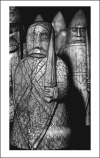 |
Scottish Annotated Games |
Last updated 11 July 2001


|
Leko, P (2701) - Craig, T J (2425) [B90]
EM/TT/F/01 ICCF Email, 1999
[Notes by Tom Craig]
1.e4 [OTB, you smile, shake hands, maybe pull up your socks, and then
play your first move. In CC, you can receive an entire CV of your
opponent's life so far! Domenico kept it professional but polite - "I'm
pleased to meet you".]
1...e5 2.f4 Nc6 [Domenico suggested: "if 2...
exf4 3.Nf3". This, combined with the postal service often making games
against Italian opponents long, boring, drawn-out affairs, prompted me to be
slightly wicked in my choice of defence.]
3.Nf3 [After 3.Bc4 Nf6
Black has a comfortable game. Although it is over a decade since I
abandoned the King's Gambit, I suspect that my preference would have been
3.Nc3 transposing into the safe waters of the Vienna Gambit, but my opponent
is no coward!]
3...f5!? [The Adelaide Gambit.] 4.exf5 [4.d4?
exd4!; 4.fxe5?? fxe4 5.Ng1 Nxe5-+; 4.d3] 4...e4 5.Ng5?! [5.Ne5 Nf6
6.Nc3 (6.d3+= Gallagher) Bd6; 5.Qe2? Qe7-+] 5...Nf6 6.Be2 [6.d3 Qe7!?
7.Be2 exd3 8.Qxd3 Nb4! 9.Qb3 h6=+ Monaville v Wahls, Luxembourg 1989.]
6...Bc5 7.Bh5+ Kf8!? [I was totally unconvinced by 7... Ke7 8.Nf7
(8.d3; 8.Nc3) Qe8 9.Nxh8 Qxh5 (9... Nxh5 10.Qg4!) 10.Qxh5 Nxh5 Weijers v
Olthof, Rosmalen 1995 (11.Nc3!; 11.d3!?)] 8.Nc3 Qe7 [8... d5?? 9.Nf7
Qe8 10.Nxd5+-; 8... d6 9.Nf7 (9.Ncxe4 Qe7!) Qe8 10.Nxh8 Qxh5 11.Qxh5 Nxh5
12.g4 Nf6 13.g5 Nh5 14.f6 gxf6 15.Nxe4 Kg7=+]
9.Na4?! [While
annotating another game, I tracked back and removed my comments regarding
this move - it brought into my mind thoughts of pots, kettles and the colour
black! There can be a flippancy and arrogance in the annotations of a game
that was demanding for both players. A game such as this is like nail
varnish - it gets harder as it goes on! The simplicity of the notes fails
to convey the long time spent, often in the wee hours of the morning, not
only looking at the future course of the game, but also just trying to find
the next move.]
9...Nd4 10.c3 Nxf5!? [A suggested continuation by
Domenico at this point saved me wasting valuable time having to consider
10... Nxh5 11.Qxh5 (11.Nxc5 Nxf4) Nc2+ 12.Kd1 Nxa1 13.Nxc5 d5 14.Nce6+ Bxe6
15.Nxe6+]
11.b4?! [11.Nxc5 Qxc5 12.Be2 (12.Nf7 Rg8 13.Ne5 d6) h6
13.Nh3 d5 14.d4]
11...Bd6 12.0-0 g6 13.Be2 h6 14.Nh3 Kg7 15.Re1?! [A
moment's thought in a blitz game would have led me to 15.Bb2 lining up the
bishop on the same diagonal as the Black king.]
15...b6 [15... a5
16.a3 Re8 (16... c6) 17.Bb2 b6 18.g4!; 15... c6?! intending Bc7 followed by
d5 is appealing, but too slow.]
16.Bf3 [16.d3; 16.Bc4; 16.Bb2 Bb7
17.g4 Nh4] 16...Qf7 [Did I seriously consider 16... Bb7 17.d3 exf3!?
as my notes seem to suggest? There is one benefit of CC, you can go to bed
and sleep on it.]
17.Bxe4 Nxe4 18.Rxe4 Bb7 19.d3!? [19.Re1 Nh4!]
19...Rhe8 [19... Bxe4? 20.dxe4 Nh4 21.g3 Qe6 22.Nf2 Rhf8 23.Nb2
(23.gxh4? Bxf4 24.Bxf4 Rxf4 25.Qd4+ Kh7 26.Qd5 Qxd5 27.exd5 Re8)]
20.Nf2
[20.Rxe8 Rxe8 21.Bb2? Bxg2; 20.g4 Nh4 21.Re3? Qd5!-+] 20...Bf8
[Ok, I confess that I do enjoy playing minor pieces back to their
original squares. 20... Ne7 (intending Nd5) 21.Qb3 (21.Re1 Nd5 22.g3 Rxe1+
23.Qxe1 Re8 24.Qd1 b5 25.Nc5 Bxc5 26.bxc5 Nxc3 27.Bb2 b4 28.Bxc3+ bxc3
29.Qc2 Qf6 30.Rc1 Qd4) Qxb3 22.axb3 Bxe4 23.dxe4 c6 24.Be3 Bc7; 20... Re6
(intending Rae8)] 21.Rxe8 [21.g4 Bxe4 22.dxe4 Nd6-+; 21.Bb2 Bxe4
22.dxe4 Nd6 23.c4+ Kh7-+]
21...Rxe8 22.Bd2 [22.d4?? Qd5!; 22.Ne4 Bxe4
23.dxe4 Rxe4 24.Nb2 Qe6 and I would have been happy with my position eg.
25.Bd2 Nh4! and g2 is very vulnerable after Re2 and in some lines directly
by Nxg2; 22.Nb2 Nh4-+]
22...Qd5 [22... Nh4!? 23.Ne4 (23.Qf1? Bxg2-+)
Bxe4 24.dxe4 Rxe4-+] 23.Qg4 [23.Qf1 Nh4; 23.Ne4? Qxd3-+] 23...Nh4
[intending Qxg2] 24.Re1 [24.f5 Qxg2+ 25.Qxg2 Bxg2 26.Bf4 Bc6
27.Nb2 Nxf5 28.Bxc7 d6!-+; 24.c4 Qxg2+ 25.Qxg2 Bxg2 (25... Nxg2 26.Ne4 Nh4
27.Bc3+ Kf7) 26.Bc3+ Kf7 (intending Bd6)]
24...Rxe1+ 25.Bxe1 Qxg2+
26.Qxg2 Nxg2 27.Bd2 [27.Kf1 Nxe1 28.Kxe1 Bd6-+] 27...Bd6 28.Nh3
[28.c4 Nxf4 29.a3 Ne2+ 30.Kf1 Bf3] 28...Nh4 [Stronger than 28...
Kf6 29.Nb2 Kf5 30.Nc4. There is no rush to pick up the f-pawn; the h-pawn
is a bigger prize as it immediately creates a passed pawn.]
29.Kf2
[29.Bc1 Nf3+ 30.Kf2 Nxh2 31.Kg3 Nf3] 29...Nf3 30.Be3 Nxh2 31.Bd4+ Kf7
32.Nb2 Nf3 33.Be3 [It is impossible for White to tread water, eg. 33.Bh8
Be7 34.Ng1 Bh4+ 35.Kf1 Nxg1 36.Kxg1 Bg3 37.Nc4 d6] 33...Be7 34.Ke2
[34.Nc4 d6 35.Nd2 Nxd2 36.Bxd2 Ke6 37.Kg3 Kf5] 34...Ke6 35.Nc4
[35.f5+ Kxf5 36.Bxh6 g5-+; 35.Bc1 Bf6 36.Nd1 Nh4-+; perhaps 35.Nd1
hoping to play the knight to e3 at some point.]
35...Bf6 36.Nd2 Nxd2
37.Kxd2 [37.Bxd2 Kf5 38.c4 g5!? (38... h5) 39.fxg5 hxg5 40.Nf2 (40.Ng1
g4 41.Be1 Kf4!?) g4] 37...Kf5 38.d4 h5!? [There was a chance that if
this pawn was quickly converted to a queen, the game would end before the
century ran out! Also, a knight is the only piece that struggles against a
passed rook pawn.]
39.c4 [39.Ng5 Bd5 (39... Bxg5? 40.fxg5 h4 contains
all the risks of a bishops of opposite colours ending and was best avoided!)
40.a3 Kg4 41.Ke2 h4 42.Kf2 Be7 43.Kg1 Bd6 44.Nh7 Kf5 45.Kf2 Bxf4]
39...Kg4 40.Nf2+ [40.Ng5 h4 41.d5 h3] 40...Kf3 41.a4 [41.d5
Bc3+ 42.Kxc3 Kxe3; 41.Nd3 d6 42.Ne1+ Kg3] 41...h4 42.a5 Kg2 0-1
| Click to return to index page Games Index |
Click to download in PGN format Acunzo v Craig |
Generated with ChessBase 7.0 |





















